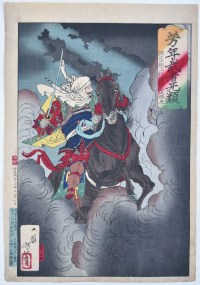/category/highlights/
Utagawa HIROSHIGE (1797-1858)
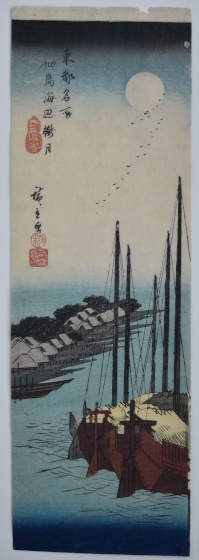
Click here to view image full size.
Spring moon at the shore of Tsukudajima . One of a set of chu-tanzaku prints published by Shogendo, c. 1837. Tsukudajima was one of two islands at the mouth of the Sumida River. Originally a sanbar, it was reclaimed with earth and rocks and given its name by the first Tokugawa Shogun, Ieyasu, who invited thirty-three fishermen to live there in 1613 in order to provide fish for the rapidly expanding city of Edo. The fishermen came from Tsukudama near Osaka and it was they who became the proprietors of what would become the Tsukiji fish market. It must have been popular during the late Edo period as a place to visit and view the boats from teahouses on the shore because there are many prints depicting the area, especially under a full moon.
Fine impression, colour and condition. Signed Hiroshige ga. n.
Status: Available
Toyohara KUNICHIKA (1835-1900)
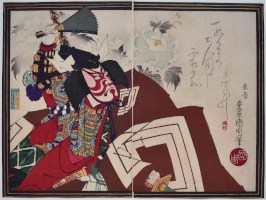
Click here to view image full size.
A diptych showing the actor Ichikawa Danjuro IX as Kamakura Gongoro Kagemasa in the drama Shibaraku, “Just a moment.” The large sansho (three square) motif was the symbol of the Danjuro clan and is repeated around the border. In the background are peonies, also associated with the Danjuro clan. Published by Tanaka Katsuzo, 1878.
Fine impression, colour and condition. Signed Oju Toyohara Kunchika hitsu.
Status: Available
Tsukioka YOSHITOSHI (1839-1892)
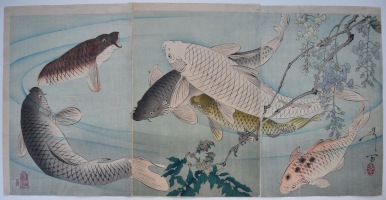
Click here to view image full size.
A triptych showing carp swimming beneath wisteria. A rare and extremely unusual subject in Yoshitoshi’s canon of work. Koi are symbols of love and friendship in Japan. The breeding of ornamental carp began in the 1820s. The outside world was unaware of the advances in breeding colour variations until an annual exposition in Tokyo in 1914. Published by Akiyama Buemon, 1889. There is an original drawing, most likely for this triptych, elsewhere on this site. A much sought after design.
Very fine impression. Fine colour. Completely untrimmed with the extra margins around. Fine condition. Signed Yoshitoshi ga.
Status: Available
Keisai EISEN (1790-1848)
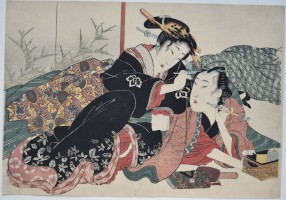
Click here to view image full size.
An amorous couple from an unsigned abuna-e (from abunai, risqué) set of twelve prints Keisai higo, “Secret Words of a Courtesan” published c. 1822-25. Although coming under the heading of shunga, each print is without any graphic details. She adjusts his hair with her hairpin while he smokes a pipe.
Fine impression, colour and condition. (Without centre fold, which is often encountered on this set.
Status: Available
Tsukioka YOSHITOSHI (1839-1892)
Uesugi Kenshin Nyudo Terutora. Shows Uesugi no Terutora (aka Kenshin) riding into battle through clouds of smoke against his long-standing adversary Takeda Shingen. From a set of 33 prints Yoshitoshi musha burui, “Yoshitoshi’s Courageous Warriors.” Published by Kobayashi Tetsujiro between 1883 and 1886, this being 1883. A fine design.
Very fine impression of the first edition. (Which should have a three-colour cartouche; two red seals and the publisher’s address in blue in the left margin.) It was reprinted by Tsunajima Kamekichi in 1886 and there are many late printings of the set. Fine colour and condition. Full size with extra paper at left. Signed Taiso Yoshitoshi ga.
Status: Available
Tsukioka YOSHITOSHI (1839-1892)
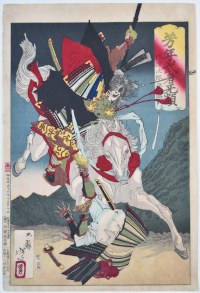
Click here to view image full size.
Shows Sagami Jiro Taira no Masakado on horseback attacking an opponent and having cut his sword in two. From a set Yoshitoshi musha burui, “Yoshitoshi’s Courageous Warriors.” Published by Kobayashi Tetsujiro, 1883.
Very fine impression: This is the first edition with three-colour cartouche and small red seals in left margin. There are late editions of this set. It was republished by Tsunajima Kamekichi in 1886. Fine colour. Slight soil bottom edge, otherwise very good condition. Signed Taiso Yoshitoshi ga.
Status: Available
Suzuki HARUNOBU (1724-1770)
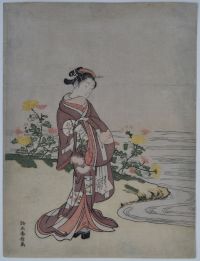
Click here to view image full size.
A beauty standing beside a stream where wild chrysanthemums grow. A mitate-e (parody) of Kikujido, the Chrysanthemum Boy, who was the favourite of the Chinese Emperor Mu (c. 950 B.C.). However, because of court jealousy, he was banished but had his exile eased by the Emperor who gifted him the ability to read sacred Buddhist texts. He became an immortal, spending his days surrounded by chrysanthemums and inscribing words of peace on the flowers’ petals. This is the second state: The first (private edition) is a calendar print with a signature (of an amateur) Kinga Ko and seal and has the year and its cyclical signs for 1766. These Harunobu calendar prints, printed in small numbers, were commissioned by wealthy individuals between c. 1764 and 1766 and so popular that they were published commercially. Rare.
Very good impression and colour Very minor edge soil, otherwise very good condition. Signed Suzuki Harunobu ga.
Status: Available
Hosoda EISHI (1756-1829)
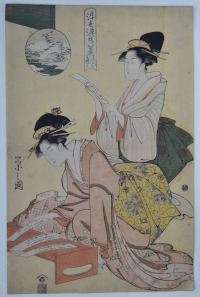
Click here to view image full size.
Two beauties examining tanzaku poetry cards from a set Ukiyo Genji hakkei, “Eight Views of Genji in the Floating World.” The designs stand alone but also form diptychs. This series compares scenes from the famous Tale of Genji novel written by the Lady Murasaki in the early 11th century with the Eight Views of Omi [Lake Biwa]. In the present case, Maboroshi rakugan (viz Katata rakugan, “Descending Geese at Katata”) is compared to chapter 41, Spirit Summoner, of the Tale of Genji where a poem composed by the Akashi Lady is in response to the grieving Genji’s poem after the nocturnal encounter with Murasaki which refers to the wild goose (aka Genji) having flown away. Published by Eijudo c 1797-99. Another impression is in the B.M., reg. no. 1931, 0427,0.8 and an impression is illustrated in Klaus J. Brandt, Hosoda Eishi, 1977, 119, no. 301. Provenance: Sold Sothebys, New York, 28/10/1980, lot 866.
Fine impression. Very good colour with yellow ground. Slight centre fold and very slight trimming, otherwise very good condition. Signed Eishi zu.
Status: Available
Kitagawa UTAMARO (1754-1806)
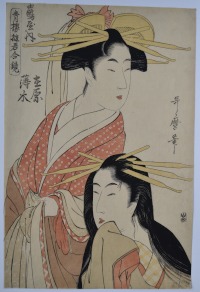
Click here to view image full size.
A double-bust portrait of the famous courtesans Ariwara (bottom) and Usumizu of the Tsuruya House in the Yoshiwara, Edo. From a set Seiro yukun awase kagami, “Mirror of Courtesans of the Green Houses.” Published by Yamada, c 1797.
Fine impression. Very good colour. Very slight trimming, otherwise very good condition. Signed Utamaro hitsu.
Status: Available
Yamamoto FUJINOBU (Active 1750-1770)

Click here to view image full size.
An original painting, full colour on paper, image size 32.25 x 7 in; 82 x 18 cms. Shows a parading courtesan with her kamuro. A painter and print artist whose prints were always published by Yamamoto Fusanobu giving rise to the theory that Fujinobu was a pseudonym of the publisher. Much influenced by Harunobu. His prints are extremely rare. Slight creasing, otherwise good condition. Signed Fujinobu ga with indistinct seal.
Status: Available

Click here to view image full size.
Tsukioka YOSHITOSHI (1839-1892)
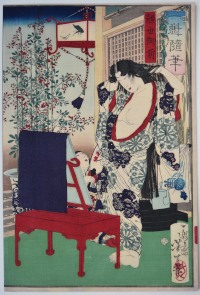
Click here to view image full size.
The great beauty Lady Kaoyo (Gozen) admires herself in a long morror. Lord Ko Moronao, the chief retainer of Shogun Ashikaga Takauji, hears of her beauty and connives to spy on her after her bath. He falls in love, but she is married to En’ya Hankan Takasada. The evil Moronao plots against En’ya although the outcome is that the family is put to death, including En’ya’s wife. The story forms the basis of the famous Chushingura tale. From the set Ikkai zuihitsu, “Essays by Yoshitoshi.” (Ikkai was an early name of Yoshitoshi’s.) A set of thirteen prints published by Masadaya Heikichi 1872/3. A fine set.
Extremely fine impression and colour from the first edition. Most designs from the set have red seals in the margin and red seals over the signature. These were removed on later editions. Trimmed on black border at left, otherwise fine condition. Signed Ikkaisai Yoshitoshi hitsu.
Status: Available
Utagawa HIROSHIGE (1797-1858)
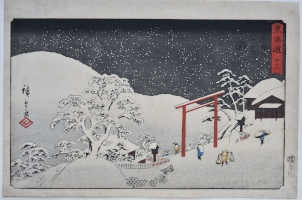
Click here to view image full size.
Seki from a Tokaido set published by Maruya Seijiro, 1850-51, hence it is often referred to as the Marusei Tokaido. Also known as the Reisho Tokaido because the title “Tokaido” is written in formal script. Below is the station number 48. Seki was located where the two highways of Tokaido and Ise-ji meet. Seki means “barrier checkpoint.” Figures pass beneath a torii gate on a snowy hillside.
Fine impression and colour. Minor edge soil, otherwise very good condition. Signed Hiroshige ga.
Status: Available
Utagawa KUNIYOSHI (1797-1861)
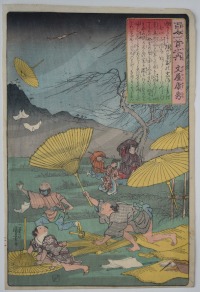
Click here to view image full size.
A poem by the celebrated poet Bunya no Yasuhide from the series Hyakunin isshu no uchi, “One Hundred Poems for One Hundred Poets” which was compiled in 1235 by Fujiwara Teika (1162-1241). The poet in the background watches as a fierce wind blows away some of the umbrellas that are being made. One of the best designs in the set published by Ebisuya Shoshichi, Ebine, 1840-42. Only 58 of the 100 are known. Various translations of the poem exist, here is one:
The mountain wind in autumn time
Is well called “hurricane”;
It hurries canes and twigs along,
And whirls them o’er the plain
To scatter them again
Very fine impression. Fine colour. Slight nibbling of border but otherwise fine condition. Signed Ichiyusai Kuniyoshi ga.
Status: Available
Utagawa KUNIYOSHI (1797-1861)
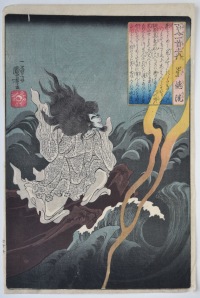
Click here to view image full size.
A poem by the celebrated poet Sutoku-in from the series Hyakunin isshu no uchi, “One Hundred Poems for One Hundred Poets” which was compiled in 1235 by Fujiwara Teiki (1162-1241). Shows the exiled Emperor Sutoku (1119-64) standing on a rocky outcrop above turbulent rapids. His wrath causes a thunderstorm with lightening. One of the very best designs from the set. Published by Ebisuya Shoshichi, Ebine, 1840-42. Only 58 of the 100 prints are known. Various translations of the poem exist, here is one:
Because the current is swift
Even though the rapids
Blocked by a boulder
Are divided, like them, in the end
We will surely meet, I know
Very fine impression. Fine colour. Very good condition. Signed Ichiyusai Kuniyoshi ga.
Status: Available
Tsukioka YOSHITOSHI (1839-1892)
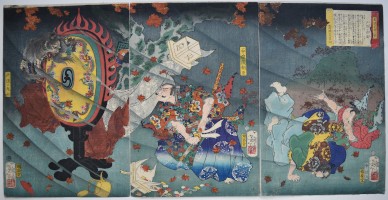
Click here to view image full size.
A triptych from a set Bidan musha hakkei, “Eight Views of Warriors’ Fine Tales.” This design Togakushi no seiran, “Clearing Weather of the Togakushi Mountains.” Princess Sarashina, who is actually a female oni called Momji, “Maple Leaves,” having transformed herself, is seen screaming from behind a giant drum and raising a high wind scattering maple leaves against Taira no Koremori Ason who draws his sword to kill her. Published by Sanoya Tomigoro, 1868.
Extremely fine impression of the earliest state. Fine colour. Slight marks on first sheet, otherwise very good condition. Signed Gekko Yoshitoshi hitsu.
Status: Available
Utagawa KUNISADA (1786-1865)
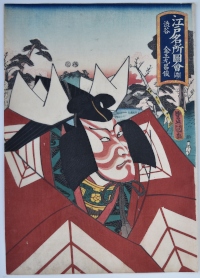
Click here to view image full size.
The actor Ichikawa Danjuro VIII as Shibuya Konnomaru Masatoshi from a set Edo meisho zue, “Famous Places of Edo.” This being Shibuya. Published by Iseya Chusuke 1852.
Very good impression. Good colour and condition. Signed Toyokuni ga.
Status: Available
Utagawa KUNISADA (1786-1865)
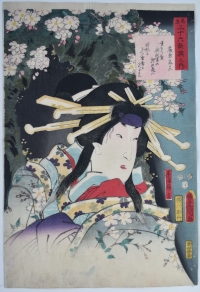
Click here to view image full size.
The actor Segawa Kikunojo III as the Spirit of the Komachi Cherry Tree from a set Mitate sanjurokkasen no uchi, “An Imaginary Thirty-six Poets.” A famous early compilation; in this case the image is inspired by a poem of Fujiwara no Motozane. The spirit is the courtesan Kurozome who appears to combat the evil plans of Sekibei (actually Otomo no Kuronushi) to cut the tree down. Published by Iseya Kanekichi, 1852.
Fine impression. Fine colour. Very small binding holes otherwise very good condition. Signed Toyokuni ga.
Status: Available
Ichirakutei EISUI (Active 1790-1823)
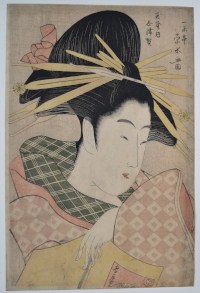
Click here to view image full size.
A fine okubi-e (“large head”) portrait of the courtesan Shizuka of the Tama-ya House. Eisui, like the other main pupils of Eishi, produced some of the finest bust-portraits in Ukiyo-e. Published by Maruya Bunemon c late 1790’s. Other impressions illustrated in Klaus J. Brandt, Hosoda Eishi, page 72, 524, no. C35, catalogued p. 231, and the Library of Congress, FP2-JPD, no. 1912. Extremely Rare.
Very good impression. Good colour. Slight soil, otherwise good condition. Full sze. Signed Ichirakutei Eisui ga.
Status: Available
Utagawa TOYOKUNI I (1769-1825)
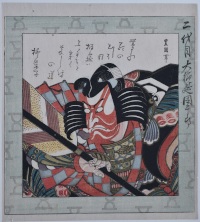
Click here to view image full size.
A surimono showing the actor Ichikawa Danjuro II as Soga no Goro Tokimune holding the giant arrow prior to sharpening it on the large wetstone from the play Yanone Goro. From a series of surimono that paid tribute to the various generations of the Danjuro family. There are two versions of this set of surimono and some ambiguity as to which is the earlier. They are known with blank borders, lacking metallic pigments and signed Ko Toyokuni hitsu (except one design signed Toyokuni II and probably issued in 1833). The other, as here, is signed Toyokuni hitsu, has metallic pigments and the emblem of the Gogawa Poetry Club around the border. The poets were also changed for this issue. It seems that the first version was issued by the Danjuro Fan Club in 1825 and that the reissue, c 1830s, was by the Gogawa. One poem by Ryueishi. The finest design from the set.
Very fine impression with metallic pigments. Fine colour and condition. Signed Toyokuni hitsu.
Status: Available
Utagawa KUNIYOSHI (1798-1861)
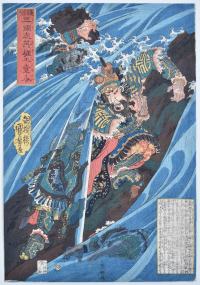
Click here to view image full size.
Cao Cao (Jap. Shuso) and Pang De (Jap. Hotoku) in the Han river during the battle with Guan Yu. From a set of Chinese warrior prints: Tsuzoku sangokushi eiyu no ichinin, “Heroes of the Popular History of the Three Kingdoms.” Published by Joshuya Kinzo, c. 1836. Robinson S10.8 (although only known as a key-block proof). Rare.
Superb impression. Very fine colour and condition. As the day it was printed. Signed Chooro Kuniyoshi ga.
Status: Available
Utagawa KUNIYOSHI (1797-1861)
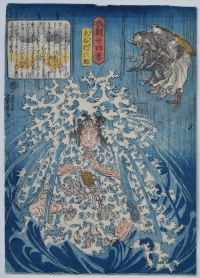
Click here to view image full size.
A fine chuban design showing Keyamura Rokusuke (aka Kida Magobee Muneharu), a famous farmer turned samurai and sumo wrestler of incredible strength, doing penance for seven days under the waterfall at Hikosan Gongen praying for his mother. Two Tengu watch from above. Waterfalls were one of the go-to-places to perform filial piety as they were considered to purify the soul in Shinto/Buddhist culture. From a set Honcho nijushiko, “Twenty-four Paragons of Filial Piety of our Country.” Published by Murataya Tetsu, 1843-6.
Fine impression and colour. Small nick out of top, otherwise very good condition. The signature Ichiyusai Kuniyoshi ga is on the extreme left edge and is often trimmed.
Status: Available
Mori SOSEN (1747-1821)

Click here to view image full size.
An original painting, sumi and light colour on silk, 42.5 x 16 in; 108 x 40.5 cms. His life is not well documented but he is known to have studied under the Kano artist Yamamoto Joshunsai (?-1781) before being drawn into Maruyama Okyo’s (1735-1795) artistic circle and his style is more Shijo than anything else. His animal paintings were evidently highly valued by Okyo. He was an immediate favourite with eastern collectors because of his monkey paintings at which he excelled, although he was more versatile than literature implies and highly accomplished at painting other animals. But his images of monkeys take precedence and he is considered the pre-eminent painter, east or west, on this subject. It is alleged that he lived in the woods for three years eating fruit and nuts to study the monkeys and other animals, and is also supposed to have had a cage of monkeys at the back of his house to better observe them. This high quality painting shows two monkeys sitting on the branch of a cherry tree. Signed Sosen with two Sosen seals. In good condition.
Status: Available
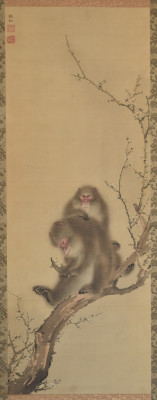
Click here to view image full size.
Kikugawa EIZAN (1787-1867)
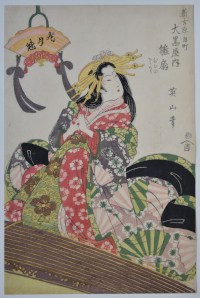
Click here to view image full size.
The geisha Hinaogi of the Daikokuya preparing to play the koto. She is adjusting the tsume (plectra) on her fingers that were used to pluck the strings. The title is enigmatic: It reads Ka getsu kai, “Harbinger of Moon and Flower” and if the character for “moon” is omitted it reads “oiran” (the highest ranking courtesan). Published by Enomotoya Kichibei, c. early 1830s. There is in fact a later copy of this print by Kunisada.
Fine impression. Excellent colour. Very good condition. Signed Eizan hitsu.
Status: Available
Utagawa HIROSHIGE (1797-1858)
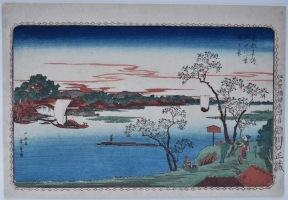
Click here to view image full size.
Sumidagawa hazakura no kei, “Cherry Trees along the Sumida River” from a Toto meisho “Famous Places in the Eastern Capital” set of ten prints published c 1831-2 by Kawaguchiya Shozo. Hiroshige’s first landscape set. The first editions, as here, have decorative borders adding a western element into the design. These were removed on later editions. There are also variant states with different shading. Rare.
Fine impression and colour. Backed, otherwise very good condition. Prints from this set are often missing or have the publisher’s name and address on the right border trimmed. Signed Ichiyusai Hiroshige ga. (The last set to be signed like this.)
Status: Available
Utagawa HIROSHIGE (1797-1858)
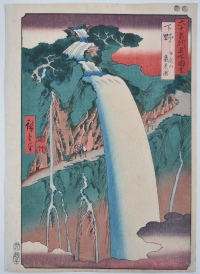
Click here to view image full size.
Shimotsuke Nikkosan urami no taki, “Back-viewed Waterfall on Mt. Nikko in Shimotsuke [Province].” From a set of 69 prints [Dai Nihon] Rokujuyoshi meisho zue, “Famous Places in the Sixty-odd Provinces [of Japan]” published by Koshihei between 1853 and 1856, this being 1853. Figures gaze up at the back of the waterfall which thunders over the path. It is also known with variant colour schemes. Fine design.
Very fine impression with strong blind-printing on the fall. Fine colour and condition. Full size. Signed Hiroshige ga.
Status: Available
Utagawa YOSHITORA (1836-1887)
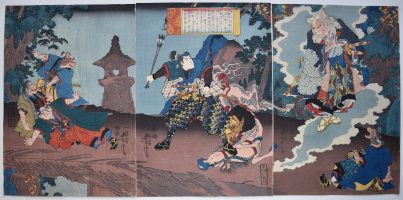
Click here to view image full size.
A triptych showing the warrior Inukai Genpachi (the famous character from the Hakkenden) confronting a cat monster which has emanated from a horse on Mount Koshin. Other cat monsters stare in amazement. Published by Kojimaya Jubei, 1850.
Very fine impression. Fine colour. Imperceptible small binding holes, otherwise fine condition. Signed Ichimosai Yoshitora ga.
Status: Available
Utagawa KUNISADA II (1823-1880)
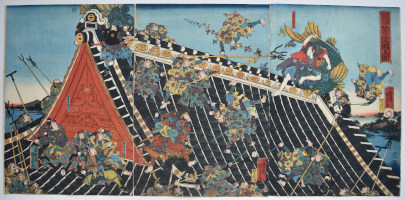
Click here to view image full size.
A triptych showing the fight on the roof of the Horyukaku Tower of Koga Castle beside the Tone River. A popular scene from the complex novel Nanso Satomi Hakkenden, “The Diary of Eight Dogs” by Takizawa Bakin (1767-1848). The macabre tale revolves around the eight offspring of a supernatural marriage between a princess and her father’s dog and their commitment to restore the fortunes of the samurai house of Satomi. Shows Inuzuka Shino Moritaka defending himself against the chief of police Inukai Kempachi Nobumichi. Published by Tsutaya Kichizo 1854.
Very good impression, colour and condition. Signed Ichijusai and Baichoro Kunisada ga.
Status: Available
